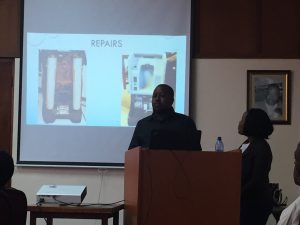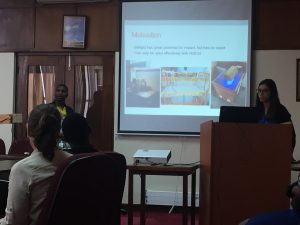This Wednesday I had a chance to visit everyone at the Polytechnic and watch their presentations. It was a wonderful opportunity to see how far everyone has come since the projects were proposed last month. Everyone has worked with their partners to find solutions and bring those to life. Although I’m sure the other interns have elaborated on the details of their designs, I’ve listed out the basics of each group (for those at home who might be a little lost).
One element that I’ve realized is integral in the Rice 360 model of designing solutions is the smooth continuation from group to group. Due to the nature of undergraduate coursework and summer internships, each project is usually worked on by numerous groups of students. One semester it’s a group of students in the global health design course, the following semester it could be an individual’s personal study, and the next summer it could go to Malawi with a team of interns! While this sounds like it might get confusing, I actually think there are lots of benefits to this process. Instead of being limited to one group of students, each project gets multiple sets of eyes and brains working and reworking how it could best benefit the intended users. For example, Millie and Kelvin’s work on the PneumaShoe has taken this two year project and completely changed some integral components. If the original group of students in Houston said, “we’re done!” and then we gave their device to a hospital in Malawi- it would not had nearly the impact it could have now that Millie and Kelvin are redesigning it.
As a lot of these solutions and devices are created for very niche settings, it’s very important to get feedback on them before trying to implement. As I’m sure you’ve read in other blogs- medical equipment graveyards are a real problem because there is no continuity between donated machines. However, not only are there these problems when the devices break, there is also the issue of devices that are working but unused. For example, one of the days that I was shadowing Prince, a study nurse in Chatinka, he pointed out a few very fancy looking incubators. He didn’t know whether or not they were still working but assumed that at least one was entirely functional. However, these incubators are only used as transportation trolleys. Why weren’t they being used to warm babies? These incubators were designed for high resource settings where the nurses have time to check on the babies through specially designed holes in the device and only one baby is on the cot at a time. In Queens it’s just not practical or possible for the nurses there. They need easy access to the baby so they can check on them quickly. If the bays are full or they want to keep a close watch on several babies, then those infants are sharing mattresses. It’s simply doesn’t make sense to try and integrate these fancy incubators into the system they have. This proves how important it is to gather as much feedback on the device as possible before trying to give it to a hospital. The solutions we are creating should be useful to those you are trying to help. I’m glad to see that process in motion with all of the engineers working at Polytechnic this summer.
Here’s a quick list of the projects!
- Serena and Chikondi have designed a final prototype stand for the bililight, a phototherapy device used to treat neonatal jaundice.
- Millie and Kelvin have adjusted the PneumaShoe (now called MwaziFlow (mwazi means blood in Chichewa)) to be a pneumatic compression device for bedridden patients. The cuff now goes around the calf, thigh, or arm instead of the foot.
- Vin and Mpha have designed the graphical user interface (GUI) for a Nurse Alert system so that patients can call the attention of a nurse from their bedside.
- Erik and Alinaya have redesigned the external filter for the oxygen concentrators to prevent the damage caused by dust.
- Naod and Webster were able to find a process to manufacture cup seals for the oxygen concentrators locally so that replacement parts are not so expensive.
- TK and Bernadette fixed several oxygen concentrators and wrote a novice training manual to teach how to fix broken equipment.
